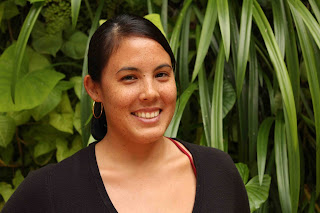Owning our Paradise
Anjani Ganase, Trinbagonian marine
biologist, continues her appeal to treasure our priceless natural resources,
and urges a return to the more entrepreneurial and direct relationship between
host homes and visitors, especially in Tobago. This feature "Owning our Paradise" was first published in Tobago Newsday, on Thursday July 21, 2016
Over the last
few years, I have been lucky enough to visit coral reef environments across the
Caribbean and in the Pacific. I have observed that many people who “live in
paradise” are able to benefit and succeed in the tourism industry, when their
first priority is to care about their own livelihoods and to protect the
coastal ecosystems in their backyards. These fortunate communities are those
that know that these natural habitats are their tourism products. And if you are
not happy in your backyard, why will anyone else be interested? It also goes beyond
that: there is no substitute for home.
I often think
back to the time when I lived in Tobago, how much I enjoyed being able to swim
laps in Grange bay after work everyday. For this simple pleasure, I felt so
lucky to live the life that others envy, and would pay a lot of money for. Tobago
is our little piece of paradise, and we ought to preserve it, first for
ourselves so that we might share it with others.
Let me share
some examples of things that other people living in paradise have done to keep
their homes a paradise, which become their drawing cards for tourism. First stop Hawai’i. On the island of Kaui’i, the
law ensures that no building is taller than a coconut tree. This law was passed
in order to conserve its coastal beauty, and to prevent high-rise hotels from
blocking the views for the resident. This has not prevented tourists from flocking
to this Garden Isle. The Na-Pali coast of Kaua’i is a natural wonder untouched by
“development.” It has become a favourite natural setting for movies such as
Jurassic park and Indiana Jones.
 |
| View of the Na-Pali coast, Kaua'i, photo by Anjani Ganase |
Next stop Mexico,
to a small island just off the coast of Cancun, known as Isla Mujeres. Cancun
has suffered severe environmental damage through the loss of coastline to hotels.
However Isla Mujeres remains a stark contrast to the hotel peninsula of Cancun.
Isla Mujeres is home to about 12000 inhabitants who reside next their very own
coral reef, known as Manchones reef. This reef has suffered greatly over the years
from physical damage from snorkellers, divers and boats, and in an attempt to
reduce the physical pressure, Dr. Jaime Gonzalez Cano, the local head of
Mexico’s Environment and Natural Resources Secretariat (SEMARNAT) took an
unconventional approach. He initiated a
system in which the divers, and snorkellers were redirected to an underwater
sculpture museum, set on the sandy flats in about 5 m of water. For this, an
English artist - Jason de Caires Taylor- was hired to create the sculptures. Taylor
used local residents as his models for the sculptures; this ensured their
physical and cultural connection to the reef and concern for its visitors (musaislamujeres.com).
I was lucky to dive among these sculptures, and was in awe of how nature added
to this artwork through natural growth of reef organisms, such as algae,
sponges and coral, on these sculptures, changing the expressions of these
sculptures over time.
Similar plans have
been made for Tobago’s Buccoo reef using the creativity of our very own masman-artist
Peter Minshall. Although this plan is clever, it will only work to its full
potential with the additional attention to improving water quality and regulating
fishing to ensure recovery of the reef.
Perhaps the most
laudable example of a country protecting their paradise at the highest level is
the Republic of Palau. An island nation in the Pacific, Palau, is closely
connected to its land and marine habitats, including coral reefs, for food and
livelihoods. In acknowledging this relationship, the Palauan government has promised
to conserve its natural resources. This is an example of a country that has
identified their biggest asset, their “island home.” And it is actively
protected at the community and the government levels to ensure that it
continues to provide income in the long-term, not just from tourism but also
from sustainable fisheries. I hope one day to visit Palau, with the comfort and
confidence that the coral reefs and the local communities will be thriving and
healthy for many decades.
Over the last
few years, there have also been shifts in the curiosity and expectations of
travellers. People no longer want to be penned in all-inclusive resorts. They
are looking for authentic relationships and experiences in the places they
visit. This is true especially for the regular budget traveller, for whom, new
online forums, such as AirBNB (airbnb.com), have opened up a world of
opportunity for people living in paradise who are willing open their homes to
travellers, offering a room or even a guest house, for the experience of living
like a local, in simple comfort. These opportunities bring the market, the
income, the story telling and connections right to your doorstep. Authentic
hospitality and original experiences are possible when the host and guest meet
each other without intermediaries. This can be the platform for an
entrepreneurial approach in Tobago. The government’s role in this would be to
support paradise with legislation, and host homes with tax and improvement
incentives.




